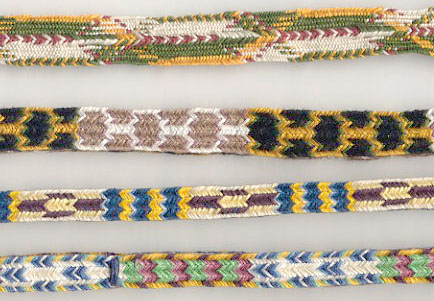| Masako Kinoshita |
Ithaca, USA
|
|
L-m Braiding: Introductory Course
L-m braiding is a technique for making braids by simply exchanging looped ends of
yarns mounted on fingers (finger-held=f-h) or held around the hands (hand-held=h-h).
The technique is historically very old and has been found in many cultural regions
in the world.
In this course participants learn techniques in which the index fingers are used
for the manipulation. The participants use cotton embroidery floss to learn to make
the three most basic braids: twin 5-element 2-ridge flat braids (simultaneously produces
two braids), a 10-element square braid and a 10-element 4-ridge flat braid in various
color combinations.
Each participant rrecieves a text-sample notebook on to which the sample swatches
made in the class may be affixed. |
āŗü[āvægĢRéŲé═ÄwüAłĮéóé═ÄĶé╠ē±éĶé╔Ŗ|é»éĮŚųüiāŗü[āvüjé╔é╚é┴éĮægÄģéīī▌é╔īŖĘéĄé─ĢRéægé▐ōkÄĶŗZ¢@é┼éĘüBŚÄjōIé╔é═ö±ÅĒé╔ī├éŁüAÉóŖEé╔ŹLéŁĢ¬ĢzéĘéķŗZ¢@é┼éĘüB
é▒é╠āRü[āXé┼é═üAāAāWāAł╚ŖOé╠Ænłµé╔ī®Åoé│éĻéķüAÉlé│éĄÄwé┼æĆŹņéĘéķŗZ¢@éÄgéóé▄éĘüB¢ž¢╚ÄhÅJÄģéŚpéóé─3ÄĒŚ▐é╠Ź┼éÓŖŅ¢{ōIé╚ægĢRüF2ÉżĢĮægĢRé2¢{ō»Ä×é╔ægé▐üA4ÉżōøžægĢRüiŖpægüjüA4ÉżĢĮægĢRé╠ægé▌Ģ¹éÅKōŠéĄé▄éĘüB
özĢzéĄéĮāeāLāXāgüEāTāōāvāŗÆĀé╔Źņé┴éĮāTāōāvāŗéō\ĢtéĄé▄éĘüB |
|
Kute-uchi: Introductory Course
This class introduces the f-h l-m braiding used today in Japan and in some Asian
countries. It also is considered to have been the one used in Japan since the 5th-7th
centuries. For this method the small or the ring fingers transfer the loops mounted
on fingers.
The participants learn using cotton embroidery floss and five loops to make the three
most basic braids: twin 5-element 2-ridge flat braids (simultaneously produces two
braids), a ten-element square braid and a ten-element 4-ridge flat braid in various
color variation.
Each participant receives a text-sample notebook on to which the sample swatches
made in the class may be affixed. |
ō·¢{ŗyéčāAāWāAé╠ēĮāJŹæé®é┼ī╗Ź▌ŚpéóéńéĻé─éóéķāŗü[āvÄwæĆŹņægĢRŗZ¢@é┼éĘüBō·¢{é┼é═5ü|7ÉóŗIé®éńŚpéóéńéĻé─éóéĮéŲŹlé”éńéĻé▄éĘüBżÄw鮢“ÄwéæĆŹņé╔Śpéóéķé▒éŲé¬üAāAāWāAł╚ŖOé╠Ænłµé┼ŚpéóéńéĻé─éóéķÉlæ}éĄÄwéÄgéżÄwæĆŹņŗZ¢@éŲé╠łßéóé┼éĘüB¢ž¢╚ÄhÅJÄģéŚpéóé─3ÄĒŚ▐é╠Ź┼éÓŖŅ¢{ōIé╚ægĢRüF5Śvæf2ÉżĢĮægĢRé2¢{ō»Ä×é╔ægé▐üA10Śvæf4ÉżōøžægĢRüiŖpægüjüA10Śvæf4ÉżĢĮægĢRé╠ægé▌Ģ¹éÅKōŠéĄé▄éĘüB
özĢzéĄéĮāeāLāXāgüEāTāōāvāŗÆĀé╔Źņé┴éĮāTāōāvāŗéō\ĢtéĄé▄éĘüB |
|
|
|
Samples of the Medieval braids
|
 |